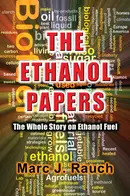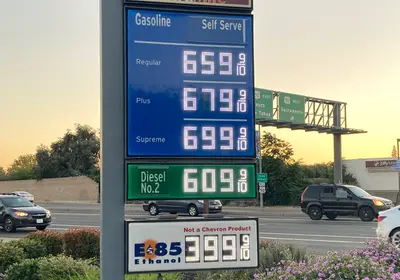One Picture Speaks A Trillion Dollars Worth of Words
High Gasoline Prices Got You Down? Look At This Picture
 Marc Rauch |
Exec. Vice President/Co-Publisher
THE AUTO CHANNEL
There's a lot of hair-pulling, finger-nail biting, and hand-wringing going on about the latest surge in petroleum oil and gasoline prices. Chicken Little is in full panic.
 |
Gasoline prices in Northern California have ranged up to $7 per gallon, and the prices in Southern California are even higher.
It's terrible, it's outrageous, it's unconscionable, and it's all B.S.
Sure, the prices are that high, and people are paying them. But there is a solution in this time of panic. The solution is not electric vehicles, it's not more oil drilling and fracking, and its definitely not tapping the National Strategic Petroleum Reserve. These solutions are not timely, too costly, or insufficient, and they only add to the filthy emissions caused by petroleum oil refining and fuels.
The only solution, the only solution that can immediately lower the price of gasoline, and reduce the amount of harmful emissions spewing into the air while bitch-smacking OPEC and Russia at the same time is very simple.
The solution is ETHANOL!
Look at the photo above...no, not the picture of the chicken or me...the picture of the Chevron fuel price board at the top. Regular gasoline is $6.59 per gallon. Mid-rage is $6.79 per gallon. Premium is $6.99 per gallon.
E85 is $3.99 per gallon. $3.99. That's $2.60 per gallon cheaper than regular; $2.80 cheaper than mid-range; and a full $3.00 cheaper than premium. That's a saving of between about 40% and 43% per gallon of fuel.
That's right, if you use E85 you will save about 40% on the cost of fuel for your vehicle. I'm not talking about a nickel, or a dime, or a quarter savings on each gallon, I'm talking about multiple dollars per gallon. And you don't have to do anything to your "gasoline-powered" vehicle to take advantage of these kinds of savings.
EVERY GASOLINE-POWERED VEHICLE ON THE ROAD RIGHT NOW CAN USE E-85
Who specifically can use E85 to save money right now? Obviously, flex fuel vehicles can completely use E85. But it's not just flex fuel vehicles, it's ALL internal combustion engine vehicles.
If you own a 2021 non-flex fuel Nissan Altima you can safely and efficiently use E30 to E50 fuel.
If you own a 2009 non-flex fuel Volvo XC90 you can safely and efficiently use E30 to E50 fuel.
If you own a 2002 non-flex fuel Ford Taurus you can safely and efficiently use E30 to E50 fuel.
How do I know this? Because I've done it.
If you own a 1956 Bentley S1 you use at least up to E30. How do I know? Because I owned one for more than 20 years starting in 1984. I imported it from England, and from the 1920s into the 1970s, ethanol-gasoline blends were regularly old in England. These blends ranged from E10 to E30. This means that all cars manufactured in Great Britain during those years were fully capable of using these ethanol-gasoline blends.
How do you get E30 to E50 ethanol-gasoline fuel? Simple, you estimate how many gallons of fuel you currently have in your tank, pull up to an E85 pump, add in anywhere from about 4 to 7 gallons of E85 (depending upon how large your fuel tank is), then pull up to a standard pump and fill the rest of the way with regular, mid-range, premium (these all typically contain E10 blends). This process is called "Splash Blending."
If you do some quick mathematical calculations you can figure out the approximate blend you are using. If you're a Millennial or are just math-challenged this might be difficult for you to do. If so, ask a friend to help or use the following examples:
A 12-gallon tank with 12 gallons of E10 is running on E10. (Using the prices above, the full tank of regular E10 would cost $79.08)
A 12-gallon tank with 8 gallons of E10 and 4 gallons of E85 would be running on approximately E35*. (Using the prices above, the full tank of E35 would cost $68.68) You'd save $10.40.
A 12-gallon tank with 6 gallons of E10 and 6 gallons of E85 would be running on approximately E47.* (Using the prices above, the full tank of E47 would cost $65.88) You'd save $13.20.
A 12-gallon tank with 12 gallons of E85 would be running on approximately E85.* (Using the prices above, the full tank of regular E85 would cost $47.88) You'd save $31.12.
*The asterisk is used because a gallon of E85 can have only about 70% ethanol and still be labeled as E85.
However, regardless of the alcohol content in the E85 you are buying, the lower price remains constant.
If you normally use a mid-range octane (89 octane) or a premium range octane (91-93 octane) the savings are even greater. For example, using the prices above, a 12-gallon tank of premium would cost $83.88. Compared to using 12 gallons of E85 ($47.88) you'd save $36.
Some people will never try this. Some people are stupid. Some people are cautious, and caution is okay. So I'll reiterate what I stated earlier, every single gasoline-powered vehicle on the road can safely and efficiently use ethanol-gasoline blends that are significantly higher than E10.
If politicians and government organizations were truly concerned with energy independence, with environmental issues, and with lowering inflation, they would be mandating the use of higher ethanol-gasoline blends.
The bottom line is this: All negative comments about ethanol fuel are incorrect. They are either lies, exaggerations, or myths. They were mostly invented by the petroleum oil industry.
Ethanol doesn't harm engines, it cleans engines. It doesn't suck water out of the air, but it will absorb water that naturally forms because of condensation. Gasoline can't do this so people have to resort to using engine additives that can cost as much as 2 or 3 gallons of gasoline. All liquids are corrosive, especially water. However, ethanol is less corrosive and is compatible with more types of rubber, plastic, and metal than gasoline and aromatics. BTU values (energy content) are irrelevant when discussing internal combustion engines. Ethanol use does not affect the price of food.
If someone is disseminating negative information about ethanol they are WRONG! I don't care who they are, where they went to school, or who they know; there are no negatives to using ethanol fuel. If any ethanol opponent is in academia or employed in an industry that comes in contact with ethanol fuel, and you disagree with me, I will be happy to debate you in public at a forum of your choosing. Contact me through The Auto Channel website.
 |
If you want more information about ethanol fuel, read my 600-page book "THE ETHANOL PAPERS." It's available to read online for FREE by CLICKING HERE..
Or click on any of the links below for additional information:
• I Just Saved 38% on a Fill-Up By Using E85 - You Can Too!
• Bust Russia ... Bust Petroleum Oil Dependency ... Bust China ... USE MORE ETHANOL
• SLAM! Shutting the File on the Tyler Lark Anti-Ethanol Study
• The Real Story On Electric Vehicles
• The Fuel Of The Future Has Been Here Since The Beginning...l
• Effort to Derail Latest E15 Decision is Faulty Wired
• American Motorcyclist Association Issues Fatuous, Delusionary Statement Against E15
• Horrific New Video Identifies Man Who Killed The Most People In History
• An Open Letter To Maine State Representative Beth O'Connor About Ethanol
• The Solution to High Gasoline Prices Is NOT Sporadic E15 Availability
• Breaking News: 100% of America's ICE Vehicles are E25 Ready!
• Open Letter to Tucker Carlson About Brazil and Energy
• Ethanol-Basher Scores 100%...in Idiocy
• Open Letter to William T. Alpert on His Fraudulent Anti-Ethanol Article
• California Forces EV Adoption, But Begs For People To Not Charge Their Electric Cars
• Open Letter to Bob Vila About Ethanol - Yes, That Bob Vila!



